People hold a flag of New Zealand following the Dawn Service ceremony at the Anzac Cove beach in Gallipoli peninsula, the site of World War I landing of the ANZACs (Australian and New Zealand Army Corps) on April 25, 1915, in Canakkale, Turkey, early Sunday, April 25, 2021. The dawn service ceremony and all other commemorative ceremonies for the 106th anniversary honouring thousands of Australians and New Zealanders who fought in the Gallipoli campaign of World War I on the ill-fated British-led invasion, were small and held without public this year due to the coronavirus pandemic.(AP Photo/Emrah Gurel)
The Associated Press
ZONNEBEKE, Belgium (AP) - On another Anzac Day turned lonesome by the global pandemic, solitary actions showed all the more how the sacrifices of Australia and New Zealand during World War I are far from forgotten.
While global attention turned at dawn on Sunday to the beaches of Turkey's Gallipoli where the two emerging countries crafted a sense of nationhood from the horrors of war in April 1915, all along the front line in Europe, small ceremonies highlighted gratitude for the so-called Anzac troops over a century after the war ended.
Unable to take part in the reduced official Gallipoli ceremonies, New Zealanders Matthew Henry and Tom Letty were still there in Turkey for their own tribute at the Lone Pine cemetery for a 'œLast Post" bugle call.
'œIt was a pretty heartfelt experience - actually standing there in the cemetery and thinking about what these guys must have gone through over a hundred years ago,'ť said Henry, 31.
It is not only Australians and New Zealanders honoring their own. The people they defended do likewise too, from such famous battlegrounds as the Somme in France and Flanders Fields in Belgium, some 2,750 kilometers (1,700 miles) west from Gallipoli along the immense front line where Anzac troops fought.
In western Belgium, Johan Vandewalle is leading a team of volunteers there that has almost finished a 40-meter long memorial to slain brothers, based on an Australian soldier named John 'œJack'ť Hunter whose remains were located decades after he died in the hands of his brother.
Born 60 years ago on the frontline of the Passchendaele Battle, Vandewalle has been steeped from childhood in the terror of the 1914-1918 global conflict that claimed 14 million lives - 5 million civilians and 9 million soldiers, sailors and airmen from 28 countries including nearly 60,000 Australians and at least 16,000 New Zealanders.
Vandewalle's playgrounds as a kid actually had soldiers still buried underneath, and the early fascination with the war turned into a lifelong passion to do justice to the fallen. He turned into an amateur archaeologist seeking to make sure that any body that was still dug up could be identified.
He immediately knew that when roadworks uncovered more bodies in 2006 there was something special about one soldier wrapped in a rubber ground sheet, hand across his heart. After he was hit by the Germans on Sept. 26, 1917, Jack Hunter's brother Jim found him dying and buried him near a marker so he could recover his remains later.
In a war in which villages and woods were razed by relentless shellfire and turned into unrecognizable mudlands overnight, Jim never recovered his brother's body, and found that hard to live with.
His niece Mollie Millis, 94, who lives in Brisbane, Queensland, said that on his deathbed Jim 'œcalled out his name when he passed. He always wanted to find him but the landscape in Flanders was so altered.'ť
Vandewalle's efforts to identify Hunter ended at Millis's doorstep, and Mollie's DNA provided the proof that Jack would indeed find a dignified resting place in 2007 at the Buttes New British Cemetery, Polygon Wood, close to where he died. 'œI will forever be grateful to Johan for taking such good care of Jack,'ť Millis said.
So touched was Vandewalle by the story of the Hunters that he started building the memorial to slain brothers, overwhelmingly based on private funding. It now awaits a bronze statue to arrive to complete the works.
To Millis, it shows the bond uniting people half a world away, even a century later.
'œIt is wonderful that Johan has managed to create a memorial for all those that lost brothers in the war. He worked so hard and over so many years and we consider him a true friend of the family,'ť Millis said.
Even if she lives many more Anzac Days, a visit will not happen. 'œI would love to see the memorial finished but I am too old now to travel that far.'ť
Vandewalle realizes his work is only a drop in an immense ocean of grief. 'œThis memorial is only the story of one set, one little story of the war. And there are so many more.'ť
Close to the Somme in northern France, Villers-Bretonneux was also sight to a horrific battle where Anzac troops died, and no local has forgotten.
'œLast year, when the Australian bushfires were at their worst, the local residents raised money to send back to Australia,'ť said Gillian Bird, Australian Ambassador to France. Those ties that were forged in terrible circumstances a hundred years ago, continue and endure."
So much so that, official or not, authorized or not, more tributes were set for Sunday.
'œWe will never forget them and we, at Villers-Bretonneux, we organized commemorations on the sly,'ť said Mayor Didier Dinouard.
____
Associated Press journalists Virginia Mayo and Mark Carlson contributed to this report from Zonnebeke, Alex Turnbull from Villers-Bretonneux and Mehmet Guzel from Gelibolu, Turkey.
A sculpture of Australian World War I soldiers John "Jack" and Jim Hunter is placed next to the Brothers in Arms Memorial in Zonnebeke, Belgium, Thursday, April 22, 2021. On another Anzac Day turned lonesome by the global pandemic, solitary actions show all the more how the sacrifices of Australia and New Zealand during World War I are far from forgotten. While global attention will turn at dawn on Sunday to the beaches of Turkey's Gallipoli where the two emerging countries crafted a sense of nationhood from the horrors of war in April 1915, all along the front line in Europe, small ceremonies will show gratitude over a century after the war ended. (AP Photo/Virginia Mayo)
The Associated Press
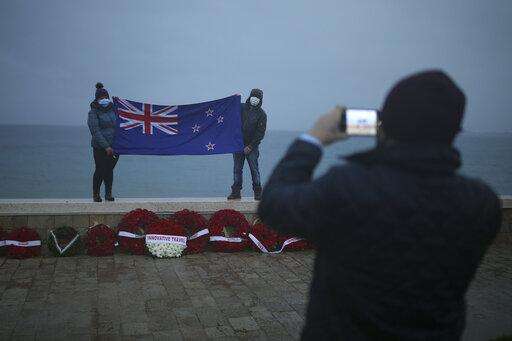
People hold a flag of New Zealand as they are photographed following the Dawn Service ceremony at the Anzac Cove beach in Gallipoli peninsula, the site of World War I landing of the ANZACs (Australian and New Zealand Army Corps) on April 25, 1915, in Canakkale, Turkey, early Sunday, April 25, 2021. The dawn service ceremony and all other commemorative ceremonies for the 106th anniversary honouring thousands of Australians and New Zealanders who fought in the Gallipoli campaign of World War I on the ill-fated British-led invasion, were small and held without public this year due to the coronavirus pandemic.(AP Photo/Emrah Gurel)
The Associated Press

The Australian National Memorial stands in Villers-Bretonneux, northern France, on Anzac Day, Sunday, April 25, 2021. On another Anzac Day turned lonesome by the global pandemic, solitary actions show all the more how the sacrifices of Australia and New Zealand during World War I are far from forgotten. (AP Photo/Michel Spingler)
The Associated Press
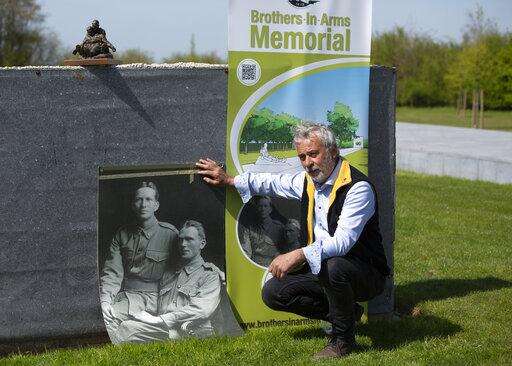
Johan Vandewalle sits near a photo of Australian brothers and World War I soldiers John "Jack" and Jim Hunter at the Brothers in Arms Memorial in Zonnebeke, Belgium, Thursday, April 22, 2021. Johan Vandewalle is leading a team of volunteers that has almost finished a 40 meter long memorial to Australian John "Jack" Hunter in Flanders Fields in Belgium, where Anzac forces also fought, some 2,750 kilometers (1,700 miles) west from Gallipoli along the immense frontline. On another Anzac Day turned lonesome by the global pandemic, solitary actions show all the more how the sacrifices of Australia and New Zealand during World War I are far from forgotten. (AP Photo/Virginia Mayo)
The Associated Press
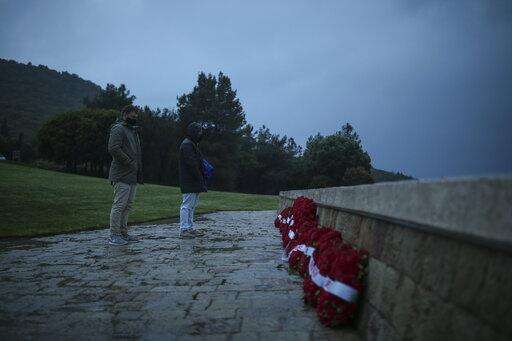
People look at wreaths following the Dawn Service ceremony at the Anzac Cove beach in Gallipoli peninsula, the site of World War I landing of the ANZACs (Australian and New Zealand Army Corps) on April 25, 1915, in Canakkale, Turkey, early Sunday, April 25, 2021. The dawn service ceremony and all other commemorative ceremonies for the 106th anniversary honouring thousands of Australians and New Zealanders who fought in the Gallipoli campaign of World War I on the ill-fated British-led invasion, were small and held without public this year due to the coronavirus pandemic.(AP Photo/Emrah Gurel)
The Associated Press

A temporary iron sculpture of Australian World War I soldiers John "Jack" and Jim Hunter sits atop the Brothers in Arms Memorial in Zonnebeke, Belgium, Thursday, April 22, 2021. The bronze statue of the Hunter brothers, currently being cast and created by Australian sculptor Louis Lauman, will form the main feature of the Brothers In Arms Memorial Park, located near the site where John "Jack" Hunter's body was discovered during roadworks in 2006. On another Anzac Day turned lonesome by the global pandemic, solitary actions show all the more how the sacrifices of Australia and New Zealand during World War I are far from forgotten. (AP Photo/Virginia Mayo)
The Associated Press
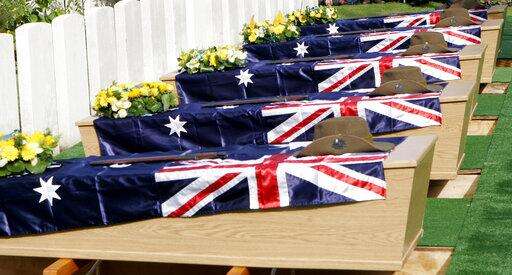
FILE - In this Thursday, Oct. 4, 2007 file photo, the flag draped coffins of five Australian soldiers, including John "Jack" Hunter, await re-burial during a ceremony at Buttes Military Cemetery in Zonnebeke, Belgium. On another Anzac Day turned lonesome by the global pandemic, solitary actions show all the more how the sacrifices of Australia and New Zealand during World War I are far from forgotten. Â While global attention will turn at dawn on Sunday to the beaches of Turkey's Gallipoli where the two emerging countries crafted a sense of nationhood from the horrors of war in April 1915, all along the front line in Europe, small ceremonies will show gratitude over a century after the war ended. (AP Photo/Virginia Mayo, File)
The Associated Press
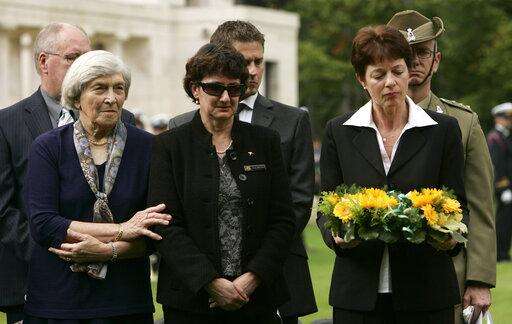
FILE - In this Thursday, Oct. 4, 2007 file photo, Mollie Millis, left, from Brisbane and niece of Australian World War I soldier Private John "Jack" Hunter, comforts Anne Morrison, center, a relative of Sergeant George Calder during a re-burial ceremony at Buttes Military Cemetery in Zonnebeke, Belgium. On another Anzac Day turned lonesome by the global pandemic, solitary actions show all the more how the sacrifices of Australia and New Zealand during World War I are far from forgotten. Â While global attention will turn at dawn on Sunday to the beaches of Turkey's Gallipoli where the two emerging countries crafted a sense of nationhood from the horrors of war in April 1915, all along the front line in Europe, small ceremonies will show gratitude over a century after the war ended. (AP Photo/Virginia Mayo, File)
The Associated Press

Amateur archeologist Johan Vandewalle shows photos of the discovery of the body of Australian World War I soldier John "Jack" Hunter, at his cafe in Zonnebeke, Belgium, Thursday, April 22, 2021. On another Anzac Day turned lonesome by the global pandemic, solitary actions show all the more how the sacrifices of Australia and New Zealand during World War I are far from forgotten. Â While global attention will turn at dawn on Sunday to the beaches of Turkey's Gallipoli where the two emerging countries crafted a sense of nationhood from the horrors of war in April 1915, all along the front line in Europe, small ceremonies will show gratitude over a century after the war ended. (AP Photo/Virginia Mayo)
The Associated Press
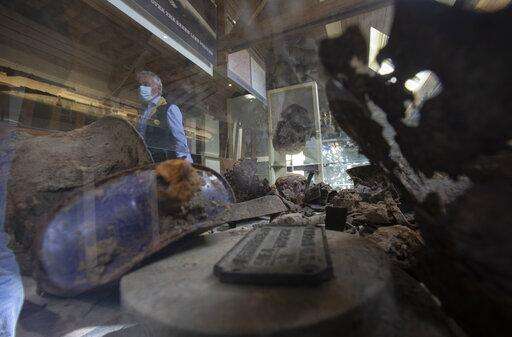
Belgian amateur archeologist Johan Vandewalle stands behind a glass case containing World War I items found in the vicinity of Polygon wood in Zonnebeke, Belgium, Thursday, April 22, 2021. On another Anzac Day turned lonesome by the global pandemic, solitary actions show all the more how the sacrifices of Australia and New Zealand during World War I are far from forgotten. Â While global attention will turn at dawn on Sunday to the beaches of Turkey's Gallipoli where the two emerging countries crafted a sense of nationhood from the horrors of war in April 1915, all along the front line in Europe, small ceremonies will show gratitude over a century after the war ended. (AP Photo/Virginia Mayo)
The Associated Press
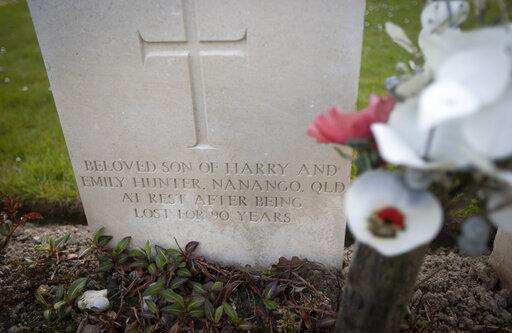
An epitaph on the grave of Australian World War I soldier John "Jack" Hunter in Buttes New British Cemetery, in Zonnebeke, Belgium, Thursday, April 22, 2021. On another Anzac Day turned lonesome by the global pandemic, solitary actions show all the more how the sacrifices of Australia and New Zealand during World War I are far from forgotten. Â While global attention will turn at dawn on Sunday to the beaches of Turkey's Gallipoli where the two emerging countries crafted a sense of nationhood from the horrors of war in April 1915, all along the front line in Europe, small ceremonies will show gratitude over a century after the war ended. (AP Photo/Virginia Mayo)
The Associated Press
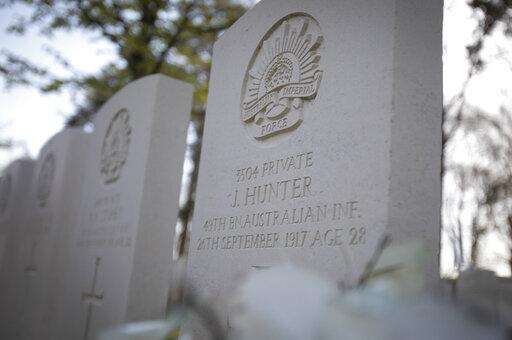
Flowers are placed in front of the grave of Australian World War I soldier John "Jack" Hunter in Buttes New British Cemetery, in Zonnebeke, Belgium, Thursday, April 22, 2021. On another Anzac Day turned lonesome by the global pandemic, solitary actions show all the more how the sacrifices of Australia and New Zealand during World War I are far from forgotten. Â While global attention will turn at dawn on Sunday to the beaches of Turkey's Gallipoli where the two emerging countries crafted a sense of nationhood from the horrors of war in April 1915, all along the front line in Europe, small ceremonies will show gratitude over a century after the war ended. (AP Photo/Virginia Mayo)
The Associated Press

Belgian amateur archeologist Johan Vandewalle displays a practice bayonet gun used in training of World War I soldiers, at his museum at Polygon wood, in Zonnebeke, Belgium, Thursday, April 22, 2021. Born 60 years ago on the frontline of the Passchendaele Battle, Vandewalle has been steeped in the horrors of the 1914-1918 global conflict. On another Anzac Day turned lonesome by the global pandemic, solitary actions show all the more how the sacrifices of Australia and New Zealand during World War I are far from forgotten. Â While global attention will turn at dawn on Sunday to the beaches of Turkey's Gallipoli where the two emerging countries crafted a sense of nationhood from the horrors of war in April 1915, all along the front line in Europe, small ceremonies will show gratitude over a century after the war ended. (AP Photo/Virginia Mayo)
The Associated Press
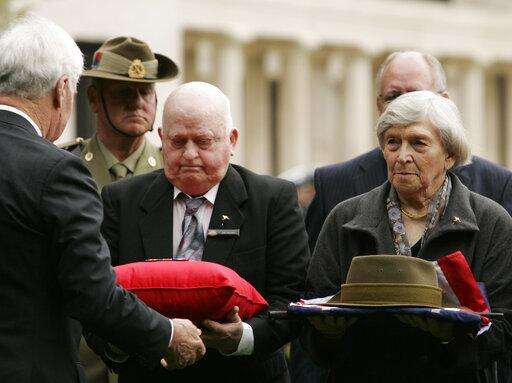
FILE - In this Thursday, Oct. 4, 2007 file photo, Mollie Millis, right, from Brisbane and niece of Australian World War I soldier Private John "Jack" Hunter, holds the presentation of effects from her uncle during a re-burial ceremony at Buttes Military Cemetery in Zonnebeke, Belgium. On another Anzac Day turned lonesome by the global pandemic, solitary actions show all the more how the sacrifices of Australia and New Zealand during World War I are far from forgotten. Â While global attention will turn at dawn on Sunday to the beaches of Turkey's Gallipoli where the two emerging countries crafted a sense of nationhood from the horrors of war in April 1915, all along the front line in Europe, small ceremonies will show gratitude over a century after the war ended. (AP Photo/Virginia Mayo, File)
The Associated Press
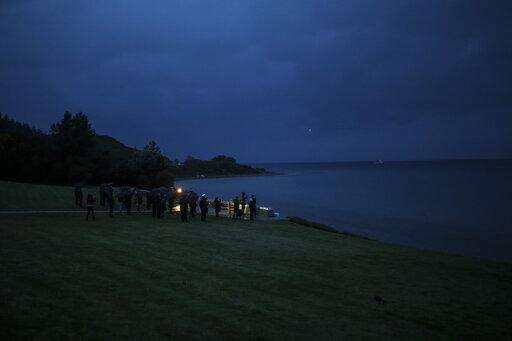
Dignitaries and military personnel attend the Dawn Service ceremony at the Anzac Cove beach in Gallipoli peninsula, the site of World War I landing of the ANZACs (Australian and New Zealand Army Corps) on April 25, 1915, in Canakkale, Turkey, early Sunday, April 25, 2021. The dawn service ceremony and all other commemorative ceremonies for the 106th anniversary honouring thousands of Australians and New Zealanders who fought in the Gallipoli campaign of World War I on the ill-fated British-led invasion, were small and held without public this year due to the coronavirus pandemic.(AP Photo/Emrah Gurel)
The Associated Press